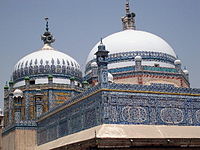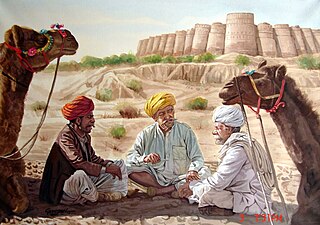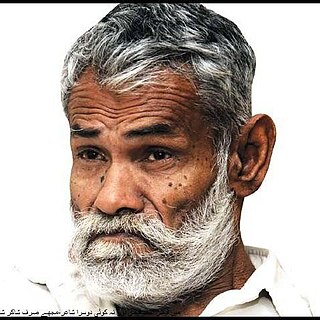
Saraiki culture is the culture of the Saraiki people, residing in Pakistan and outside Pakistan.

Saraiki culture is the culture of the Saraiki people, residing in Pakistan and outside Pakistan.
The traditional dress of Saraiki People is the Shalwar kameez that usually they wear and which is the national dress of Pakistan. Traditional Sajarak is an important part of male and female dress.
Mango is a seasonal fruit of the region during summers. [1] Sohan halwa is a traditional speciality of southern Punjab, particularly Multan. [1] The southern Punjab cities of Dera Ghazi Khan, Bahawalpur, Uch Sharif and Mailsi are also known for their sohan halwa products. [1] Multani Chaamp is a meat dish consisting of lamb chops prepared with various flavours and spices, placed on sewers and grilled over charcoal. [2]
The region of Southern Punjab is renowned for its Sufi heritage. The city of Multan is known as the city of saints. [3] It has the shrines of Baha-ud-din Zakariya and Shah Rukn-e-Alam. Similarly, Uch Sharif has been the centre of Qadiriyya Sufi order.
Jhumar or Jhoomar (also called Ghumbar in Sandalbar area) [4] is a traditional Saraiki and Baloch dance in Pakistan. [5] [6] It is also popular in the Sandalbar areas of Punjab. [7] It is slower and more rhythmic form. [8] The word "Jhumar" comes from Jhum/Jhoom, which means Swaying. Jhumar is performed at the wedding ceremonies usually. [9] The dance is also performed in circle, to the tune of emotional songs. [9] Ataullah Khan Esakhelvi and Shafaullah Rokhri are considered the main singers of Saraiki music. [10]

The language, partly codified during the British Raj, derived its emotional attraction from the poetry of the Sufi saint, Khawaja Ghulam Farid, who has become an identity symbol. [11] His poems, known as Kafi are still famous.
Shakir Shujabadi (Kalam-e-Shakir, Khuda Janey, Shakir Diyan Ghazlan, Peelay Patr, Munafqan Tu Khuda Bachaway, and Shakir De Dohray are his famous books) is a very well recognized modern poet. [12]

The Department of Saraiki, Islamia University, Bahawalpur was established in 1989 [13] and the Department of Saraiki, Bahauddin Zakariya University, Multan [14] was established in 2006. Saraiki is taught as a subject in schools and colleges at higher secondary and intermediate. [15] [16] Saraiki is also taught at degree level at the Allama Iqbal Open University at Islamabad, [17] and the Al-Khair University at Bhimbir have Pakistani Linguistics Departments. They offer M.Phil. and Ph.D in Saraiki. The Associated Press of Pakistan has launched a Saraiki version of its site, as well. [18]
| Saraiki alphabet |
|---|
| آ ا ب ٻ پ ت ٹ ث ج ڄ چ ح خ د ڈ ݙ ذ ر ڑ ز ژ س ش ص ض ط ظ ع غ ف ق ک گ ڳ ل م ن (ں) ݨ و ہ ھ ی ے |
Extended Perso-Arabic script |
Saraiki is written using the Arabic-derived Urdu alphabet with the addition of seven diacritically modified letters to represent the implosives and the extra nasals. [19] [lower-alpha 1] In Sindh the Sindhi alphabet is used. [20] The calligraphic styles used are Naskh and Nastaʿlīq. [21]
Historically, traders or bookkeepers wrote in a script known as kiṛakkī or laṇḍā, although use of this script has been significantly reduced in recent times. [22] [23] Likewise, a script related to the Landa scripts family, known as Multani, was previously used to write Saraiki. A preliminary proposal to encode the Multani script in ISO/IEC 10646 was submitted in 2011. [24]

Saraiki is an Indo-Aryan language of the Lahnda group, spoken by 26 million people primarily in the south-western half of the province of Punjab in Pakistan. It was previously known as Multani, after its main dialect.
Saraiki literature is the literature of the Saraiki language of Pakistani Punjab.

Baha-ud-din Zakariya, also spelled Bahauddin Zakariya, and also known as Baha-ul-Haq and Bahauddin Zakariya Multani, was a Sunni Muslim scholar saint and poet who established the Suhrawardiyya order of Baghdad in medieval South Asia, later becoming one of the most influential spiritual leaders of his era.

Bahauddin Zakariya University (BZU) (Urdu: جامعۂ بہاءالدین زکریا) is a public university with its main campus located in Multan, Pakistan. Bahauddin Zakariya University was founded in 1975 as Multan University, and is the 2nd largest university in Punjab. It was renamed in 1979 in honour of a Sufi saint Baha-ud-din Zakariya (1171-1262).
Jhumar or Jhoomar is a traditional jhang dance in Pakistan, it originates from jhang. It is also popular in the Sandalbar areas of Punjab. It is slower and more rhythmic form. The word "Jhumar" comes from Jhum/Jhoom, which means Swaying. Jhumar is performed at the wedding ceremonies usually. The dance is also performed in circle, to the tune of emotional songs.
Multani may refer to:

Shujaabad is a city and the capital of Shujabad Tehsil of Multan District in the Punjab province of Pakistan. It is located 45 km (28 mi) in south off Multan. Chenab River flows in the west of the city. Neighbouring settlements include Jalalpur Pirwala, Multan and Lodhran. The city's population is about 600,000.

The Punjabi dialects and languages or Greater Panjabic are a series of dialects and languages spoken around the Punjab region of Pakistan and India with varying degrees of official recognition. They have sometimes been referred to as the Greater Punjabi macrolanguage. Punjabi may also be considered as a pluricentric language with more than one standard variety.

The Saraikis, are a Indo-Aryan ethnolinguistic group native to the Southwestern region of the Punjab province of Pakistan. They are multi-ethnic in origin and speak the Saraiki language.

Anwaar Ahmad is an Urdu short story writer, scholar and academician from Pakistan. Presently, he is serving as the Director General at University of Gujrat's Sialkot Campus.He has been associated with Bahauddin Zakariya University, Multan, and Government College University, Faisalabad as a teacher, researcher, and departmental head (Urdu) for over 35 years. He has also served as a visiting professor at Ankara University in Ankara, Turkey and the Urdu department at Osaka University of Foreign Studies in Osaka, Japan.

South Punjab, also proposed as Bahawalpur-South Punjab or Sairaikistan, are the names for the proposals to create a new so called province in Pakistan, out of the southern regions of Punjab. The region comprises the Bahawalpur, Multan, Sahiwal and Dera Ghazi Khan divisions. The proposed province would form about 52 percent of the total area and almost 40 percent of the population of the current Punjab province.
There are three writing systems for Saraiki:
The Saraiki diaspora refers to the dispersing of ethnic Saraikis from Pakistan's Saraiki-speaking region to other parts of the world.

Thaḷī is a Western Saraiki dialect spoken in parts of the Pakistani provinces of Punjab and Khyber Pakhtunkhwa. It has a widespread area, starting from Tank to Muzzafargarh on the eastern end of the Indus River and from Bannu running down to D I khan at the western end of the Indus River. It is classified as a northern dialect of Saraiki, although it has also been described as transitional between Shahpuri and the central Saraiki Multani dialect. Its name derives from the Thal Desert.

Saraiki cuisine refers to the native cuisine of the Saraiki people in central Pakistan. The style of cooking is present in the Saraiki-speaking region of southern Punjab, as well as parts of southern Khyber Pakhtunkhwa, northern Sindh and northeastern Balochistan. Saraiki food comprises many unique local dishes, and also shares influences with neighbouring regional cuisines. The metropolitan city of Multan is a hub of Saraiki cooking.

Dr. Shakir Shujabadi is a prominent Saraiki-language poet in Shujabad, a small city near Multan, Pakistan.
Multani is a Unicode block containing characters used for writing the Multani alphabet, a Brahmic script used in the Multan region of Punjab and in northern Sindh in Pakistan. The script is now obsolete, but was historically used to write the Saraiki language.

There are two types of Saraiki shalwar suits which originate in the southern area of Punjab, Pakistan. These are the Bahawalpuri shalwar suit and the Multani shalwar suit. The two main suits from that area.
Lutf Ali (1716–1794) was a saraiki poet from Bahawalpur, Punjab. He was born in the village of Mao in present day Rahim Yar Khan District. He wrote the popular narrative poem Saifalnāma in 1781 based on a tale from the One Thousand and One Nights.

The Shrine of Bahauddin Zakariya is a 13th-century shrine located in the city of Multan, in Pakistan's Punjab province. The tomb is dedicated to the Muslim mystic Bahauddin Zakariya, founder of the Suhrawardiyya order of Sufism. It considered to be one of the most important shrines in southern Punjab province, and is the prototype for Multan's distinct architectural style.